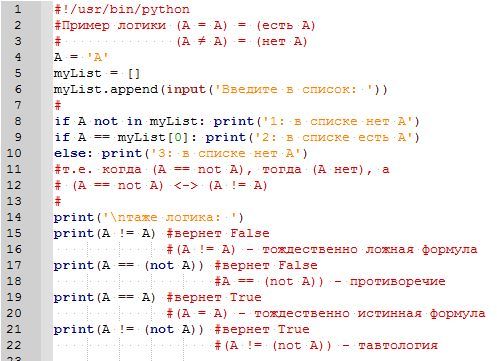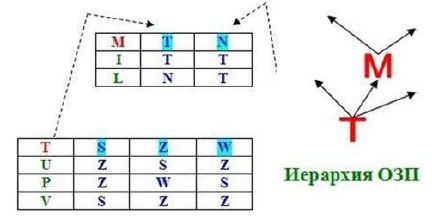There is no
First, an example of an olympiad logic problem. On the island live wise men and liars. Moreover, they yes and no sound like a bang and a puff. What exactly of them that - is unknown.
We decide. The sage will answer as follows: (A = A), (A ≠ not A). The answer is a liar in this case: (A ≠ A), (A = not A). Let the bang in their language is yes. Then the wise man will answer the question to the question (bang is yes?). If in their language (bang is not), then his answer will be the same: bang. A liar will always speak non-existent (what is not), saying puff.
So, the construction of truth (identically true formula) A = A, falsehood (identically false formula) A ≠ A. The same formulas allow you to pass logical primitives: there is A, no A. Here is an example in python.

You can express everything said this way:
')

Is it possible to go further by constructing more complex things on this base? Of course. Take for example an unambiguously closed transformation T, in which transitions are presented in tabular form (the term cybernetics):
(U: S-> Z), (U: Z-> S), (U: W-> Z), (P: S-> Z), (P: Z-> W), (P: W- > S), (V: S-> S), (V: Z-> Z), (V: W-> Z)

I note that these transitions reflect the same meaning as morphisms in category theory. If we apply a function to the function argument, we get only the function value: (F: X-> Y) or (Y = F (X)).
It would seem that such an unambiguously closed transformation is completely devoid of contradiction (an identically false formula). But let us ask ourselves: how then can we interpret, say, the transition (U: S-> Z)? It was S, it ceased to be S, Z arose. We get all the same primitives: there is S, no S & no Z, there is Z. In other words, the variable T consistently takes (speaking only about the existing) values of S, Z.
You can see that there is (exists) here interpreted as a predicate: (S - is) or (S - no). I repeat (there are OR exist), i.e. the quantifier of existence is not the same as (exists). In fact, one or more of one is not the same as one.
Whether these are applicable and not to uniquely closed transformations? Yes. So, for a uniquely closed transformation M, one of the states is our T. And you can also express its existence and non-existence: there is T = (T = T), no T = (T ≠ T)
We decide. The sage will answer as follows: (A = A), (A ≠ not A). The answer is a liar in this case: (A ≠ A), (A = not A). Let the bang in their language is yes. Then the wise man will answer the question to the question (bang is yes?). If in their language (bang is not), then his answer will be the same: bang. A liar will always speak non-existent (what is not), saying puff.
So, the construction of truth (identically true formula) A = A, falsehood (identically false formula) A ≠ A. The same formulas allow you to pass logical primitives: there is A, no A. Here is an example in python.

You can express everything said this way:
')

Is it possible to go further by constructing more complex things on this base? Of course. Take for example an unambiguously closed transformation T, in which transitions are presented in tabular form (the term cybernetics):
(U: S-> Z), (U: Z-> S), (U: W-> Z), (P: S-> Z), (P: Z-> W), (P: W- > S), (V: S-> S), (V: Z-> Z), (V: W-> Z)

I note that these transitions reflect the same meaning as morphisms in category theory. If we apply a function to the function argument, we get only the function value: (F: X-> Y) or (Y = F (X)).
It would seem that such an unambiguously closed transformation is completely devoid of contradiction (an identically false formula). But let us ask ourselves: how then can we interpret, say, the transition (U: S-> Z)? It was S, it ceased to be S, Z arose. We get all the same primitives: there is S, no S & no Z, there is Z. In other words, the variable T consistently takes (speaking only about the existing) values of S, Z.
You can see that there is (exists) here interpreted as a predicate: (S - is) or (S - no). I repeat (there are OR exist), i.e. the quantifier of existence is not the same as (exists). In fact, one or more of one is not the same as one.
Whether these are applicable and not to uniquely closed transformations? Yes. So, for a uniquely closed transformation M, one of the states is our T. And you can also express its existence and non-existence: there is T = (T = T), no T = (T ≠ T)
Source: https://habr.com/ru/post/328050/
All Articles